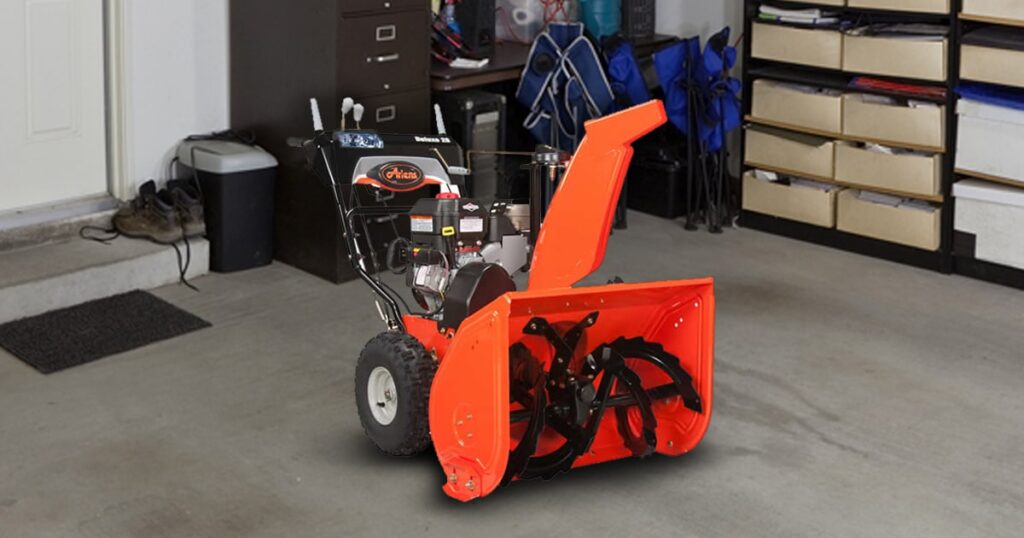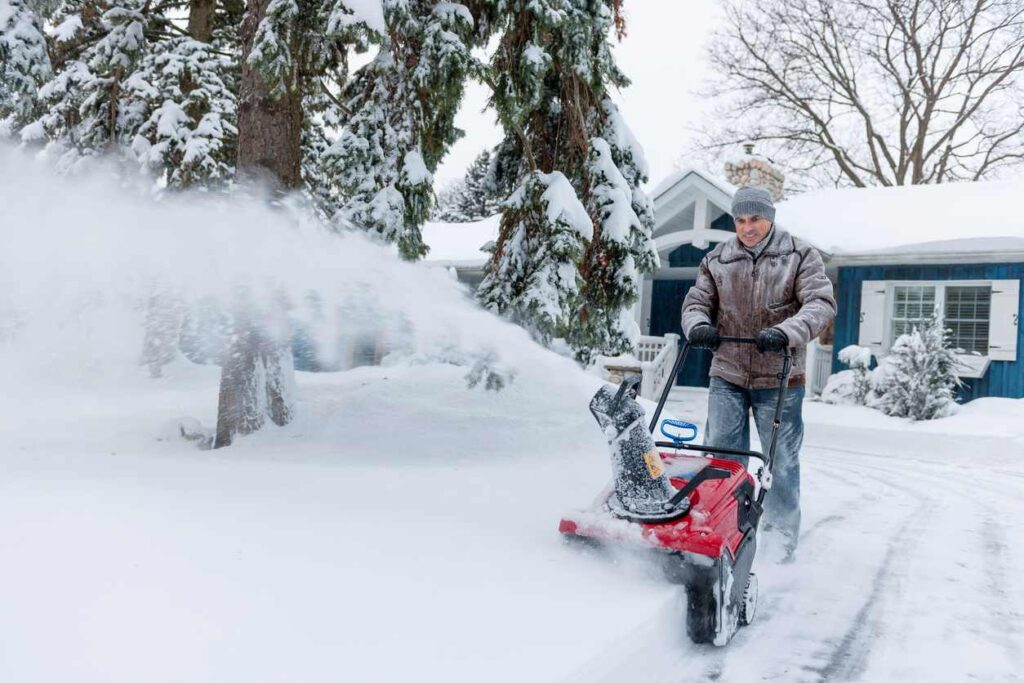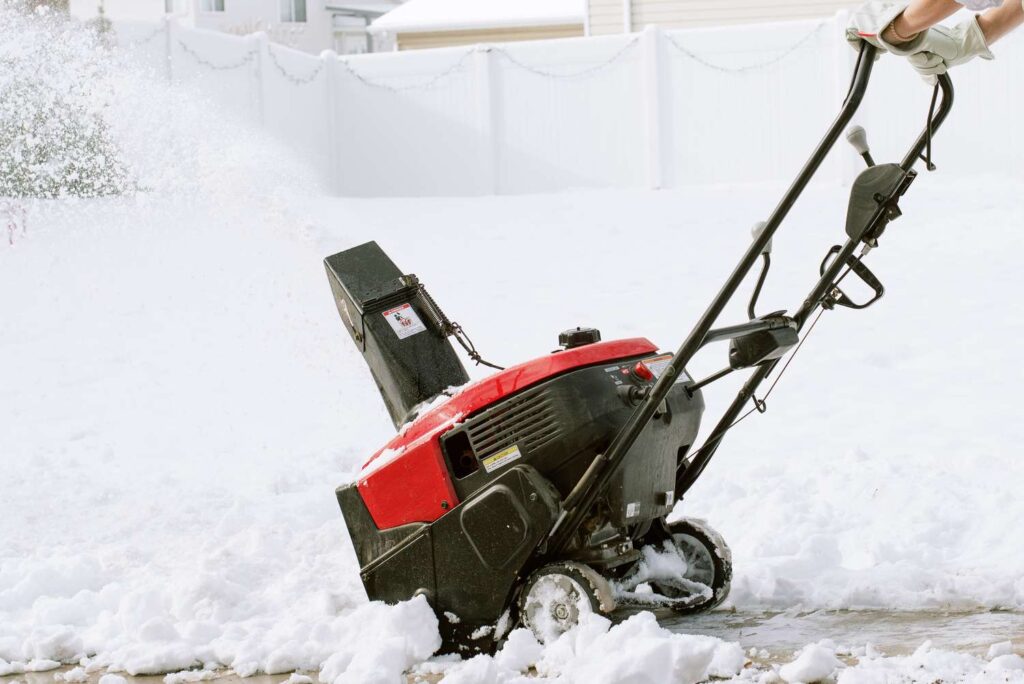In this article, we’ll be answering the question of whether or not a snowblower needs to be empty of gas before storing it for the winter. Many homeowners wonder if it’s necessary to drain the gas from their snowblower before putting it away for the season, and we’re here to provide some guidance on the matter. So, let’s dive in and find out what’s best for your snowblower!
When it comes to storing your snowblower after winter, it is generally recommended to empty the gas tank. This is because gasoline can become stale and break down over time, leading to engine issues down the line. By removing the gas from your snowblower, you can prevent the formation of gum and varnish that can clog up the carburetor and fuel lines. It’s a small task that can save you a lot of headaches when it’s time to use your snowblower again. Additionally, it’s a good idea to run the engine until it’s out of gas to ensure there is no leftover fuel in the system.
Why Emptying Gas from Snowblower is Important
Snowblowers are essential tools for clearing snow during the winter season. However, when spring arrives, it is time to store our snowblowers away until the next winter. One crucial step in winterizing a snowblower is emptying the gas from the machine. This article will discuss the reasons why it is important to remove the gas and provide a step-by-step guide on how to do it properly. We’ll also explore some tips for storing the snowblower after winter, common mistakes to avoid, and the benefits of properly storing the equipment.
Preventing Fuel Buildup
One of the primary reasons why emptying the gas from a snowblower is important is to prevent fuel buildup. Over the course of the winter season, the gas in the snowblower’s tank can deteriorate, especially if it contains ethanol. As the gas sits unused for an extended period, it can oxidize, forming varnish-like deposits that clog the fuel system. These deposits can block the fuel line, carburetor, and fuel filter, leading to poor engine performance or even a complete engine failure.
Avoiding Fuel Contamination
Another significant reason to empty the gas from a snowblower before storing it is to avoid fuel contamination. If you leave the gas in the machine over the offseason, it can attract moisture and other impurities. Moisture in the fuel can cause corrosion in the fuel tank, fuel lines, and carburetor, leading to costly repairs. Additionally, contaminants in the fuel can clog the small jets and orifices in the carburetor, which are crucial for proper fuel combustion.
By emptying the gas from the snowblower, you prevent these issues and ensure that your machine will be in good working condition when you need it again next winter.
Step-by-Step Guide to Emptying Gas from Snowblower
Now that we understand the importance of emptying the gas from a snowblower, let’s go through a step-by-step guide on how to do it properly.
Gather Required Materials
Before starting, gather the necessary materials for the task. You will need a fuel container that is suitable for storing gasoline, such as a gas can with an airtight seal. Additionally, make sure you have a pair of safety gloves to protect your hands from direct contact with the fuel.
Locate the Fuel Line
Next, locate the fuel line on your snowblower. This is usually a rubber hose that connects the fuel tank to the carburetor. Refer to your snowblower’s manual if you are unsure about the exact location.
Prepare a Fuel Container
Once you have located the fuel line, prepare the fuel container for draining the gas. Ensure that the container is clean and free of any debris that could contaminate the fuel.
Disconnect the Fuel Line
With the fuel container ready, carefully disconnect the fuel line from the snowblower. You may need to use pliers or a screwdriver to loosen any clamps or connectors holding the fuel line in place. Take caution not to damage the fuel line while doing this.
Drain the Remaining Gas
Once the fuel line is disconnected, aim it into the fuel container, and let gravity drain the remaining gas from the snowblower. You may need to tilt the machine slightly to ensure that all the gas is drained from the tank.
Dispose of the Gas Properly
After draining the gas, it is vital to dispose of it properly. Gasoline is a hazardous material and should never be poured down the drain or thrown in the trash. Check with your local waste management authorities for guidance on how to dispose of gasoline safely. In some cases, they may provide recycling centers or special collection points for hazardous waste disposal.
This image is property of lh6.googleusercontent.com.
Tips for Storing Snowblower After Winter
In addition to emptying the gas, there are a few other important steps to take when storing a snowblower after the winter season. These tips will help ensure that your machine remains in good condition and performs efficiently when you need it next.
Clean the Snowblower
Before storing the snowblower, take the time to clean it thoroughly. Remove any dirt, debris, or salt buildup from the machine. This will help prevent rust and corrosion during storage.
Inspect and Maintain the Snowblower
Inspect your snowblower for any visible damage or wear. Check the belts, auger, and other components for signs of wear and tear. Replace any damaged parts before storing the machine to avoid further issues in the next winter season. Additionally, if your snowblower has a battery, make sure it is fully charged or remove it for safekeeping.
Consider Using a Fuel Stabilizer
If you prefer not to empty the gas completely, you can consider using a fuel stabilizer. Fuel stabilizers are additives that help keep the gas fresh and prevent oxidation. They inhibit the formation of varnish and reduce the risk of fuel deterioration. Follow the manufacturer’s instructions for the appropriate amount of stabilizer to add to the gas tank.
Store in a Dry and Safe Place
When storing the snowblower, choose a location that is dry and protected from the elements. Moisture can cause rust and corrosion on the machine. Additionally, keep the snowblower away from flammable materials and sources of ignition to reduce the risk of fire. If possible, cover the snowblower with a protective tarp to prevent dust and debris from accumulating.
Common Mistakes to Avoid During Storage
While it is essential to empty the gas from a snowblower and follow the proper storage steps, there are also common mistakes that you should avoid to ensure the longevity of your machine.
Not Draining the Gas Completely
One common mistake is not draining the gas completely from the snowblower’s tank. Even a small amount of old gas left in the tank can cause problems when the machine is stored for an extended period. It is crucial to drain the gas until the tank is completely empty to prevent fuel oxidation and contamination.
Leaving Fuel in the Carburetor
In addition to emptying the gas tank, it is important to remove any fuel that may be left in the carburetor. Some snowblower models have a drain screw on the carburetor bowl that can be opened to remove the fuel. If your snowblower does not have a drain screw, you can run the machine until it runs out of gas completely. This will ensure that no fuel is left in the carburetor, eliminating the risk of carburetor issues during storage.

This image is property of www.snowblowersdirect.com.
Importance of Emptying Gas for Long-Term Snowblower Maintenance
Emptying the gas from a snowblower before storing it offers several benefits for the long-term maintenance of the machine.
Preventing Fuel Oxidation
Draining the gas from the snowblower’s tank prevents fuel oxidation. As mentioned earlier, when gas deteriorates and oxidizes, it forms varnish-like deposits that can clog the fuel system. By removing the gas, you eliminate the possibility of these deposits forming, ensuring that your snowblower’s engine performs optimally when you use it again next winter.
Minimizing Carburetor Issues
The carburetor is a critical component of a snowblower’s engine. It mixes the fuel and air to create the combustible mixture necessary for engine operation. When fuel is left in the carburetor over an extended period, it can clog the small jets and orifices, impairing the carburetor’s function. This can lead to difficulties starting the snowblower or cause the engine to run poorly. By emptying the gas, you prevent these carburetor issues and ensure smooth operation when you need it.
Benefits of Properly Storing Snowblower
Properly storing your snowblower after winter not only helps maintain its performance but also offers several benefits in the long run.
Extended Lifespan
By following the correct storage procedures, you can extend the lifespan of your snowblower. Removing the gas, cleaning the machine, and inspecting it for any necessary repairs or maintenance all contribute to keeping the equipment in good working condition. When you store your snowblower properly, you reduce the risk of unnecessary wear and tear, ensuring that it will last for many winters to come.
Efficient Performance in the Next Winter Season
Properly storing your snowblower after winter means that it will be ready for use when the next winter season arrives. By taking the time to empty the gas, clean the machine, and perform any necessary maintenance, you can ensure that your snowblower will start easily and operate efficiently. This will save you time and frustration when the snow starts falling again.

This image is property of www.absolutemgmt.com.
Considerations for Gasoline Type and Additives
When it comes to using the right gasoline for your snowblower, it is important to follow the manufacturer’s recommendations. Consult your snowblower’s manual to determine the recommended type of gasoline, typically regular unleaded with the appropriate octane rating.
Using the Recommended Gasoline Type
Each snowblower is designed to run on a specific type of gasoline. Using a different type may lead to poor engine performance or even damage. Additionally, some snowblower engines are not compatible with gasoline containing more than 10% ethanol. Check the manual or consult the manufacturer to determine if your machine can safely use gasoline with ethanol.
Understanding Fuel Additives
Fuel additives, such as stabilizers or octane boosters, can be beneficial when used correctly. However, it is important to understand the purpose and proper usage of these additives. Always follow the manufacturer’s instructions and consult your snowblower’s manual to ensure that the additives are compatible with your machine and do not void the warranty.
Safety Precautions When Handling Gasoline
When working with gasoline, it is crucial to follow proper safety precautions to protect yourself and others. Here are a few important safety tips to keep in mind:
Work in a Well-Ventilated Area
Gasoline vapors can be harmful if inhaled in high concentrations. Always work in a well-ventilated area, such as an open garage or outdoors, to ensure proper air circulation.
Use Approved Gas Containers
When storing or transporting gasoline, always use approved gas containers made specifically for holding and transporting fuels. These containers are designed to prevent leaks and minimize the risk of fire or explosion. Make sure the container is in good condition and has a tight-fitting lid to prevent spills.

This image is property of www.thespruce.com.
Conclusion
In conclusion, emptying the gas from a snowblower before storing it after winter is indeed necessary. By preventing fuel buildup and contamination, you can avoid costly repairs and ensure that your machine performs optimally when you need it. Following the step-by-step guide provided and implementing the tips for storing the snowblower properly will help you extend its lifespan and enjoy efficient performance in the next winter season. Remember to always prioritize safety when handling gasoline and consult the manufacturer’s recommendations for the correct type of gasoline and any additives. By taking these steps, you can be confident that your snowblower will be in excellent condition for many winters to come.
